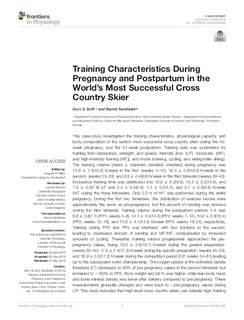| dc.description.abstract | This case-study investigated the training characteristics, physiological capacity, and body composition of the world’s most successful cross country skier during the 40-week pregnancy, and the 61-week postpartum. Training data was systemized by training form (endurance, strength, and speed), intensity [low- (LIT), moderate- (MIT), and high-intensity training (HIT)], and mode (running, cycling, and skiing/roller skiing). The training volume [mean ± standard deviation (median)] during pregnancy was 12.9 ± 7.3(10.0) h/week in the first- (weeks 1–12), 18.3 ± 2.9(18.0) h/week in the second- (weeks 13–28), and 8.8 ± 4.4(9.6) h/week in the third trimester (weeks 29–40). Endurance training time was distributed into 10.9 ± 6.2(9.9), 15.2 ± 2.3(15.6), and 7.6 ± 3.8(7.9) LIT and 0.4 ± 0.5(0.0), 1.3 ± 0.4(1.4), and 0.7 ± 0.6(0.8) h/week MIT during the three trimesters. Only 2.2 h of HIT was performed during the entire pregnancy. During the first two trimesters, the distribution of exercise modes were approximately the same as pre-pregnancy, but the amount of running was reduced during the third trimester. Training volume during the postpartum periods 1–4 was 6.6 ± 3.8(7.1) (PP1; weeks 1–6), 14.1 ± 3.4(14.3) (PP2; weeks 7–12), 10.6 ± 3.8(10.4) (PP3; weeks 13–18), and 13.6 ± 4.1(14.5) h/week (PP4; weeks 19–24), respectively. Training during PP3 and PP4 was interfered with two fractions in the sacrum, leading to decreased amount of running and MIT/HIT, compensated by increased amounts of cycling. Thereafter, training volume progressively approached the pre-pregnancy values, being 18.0 ± 3.9(18.7) h/week during the general preparation- (weeks 25–44), 17.6 ± 4.4(17.3) h/week during the specific preparation- (weeks 45–53), and 16.9 ± 3.5(17.2) h/week during the competition period (CP; weeks 54–61) leading up to the subsequent world championship. The oxygen uptake at the estimated lactate threshold (LT) decreased to 90% of pre-pregnancy values in the second trimester, but remained to ∼100% in PP3. Body weight and fat-% was higher, while lean body mass and bone mineral density was lower after delivery compared to pre-pregnancy. These measurements gradually changed and were back to ∼pre-pregnancy values during CP. This study indicates that high-level cross country skiers can tolerate high training loads during pregnancy. Although the participant had some postpartum setbacks in her training due to fractures in the sacrum, reduced overall training load, followed by a slower progression and utilization of alternative exercise modes, led to a successful return to competitions. | nb_NO |

